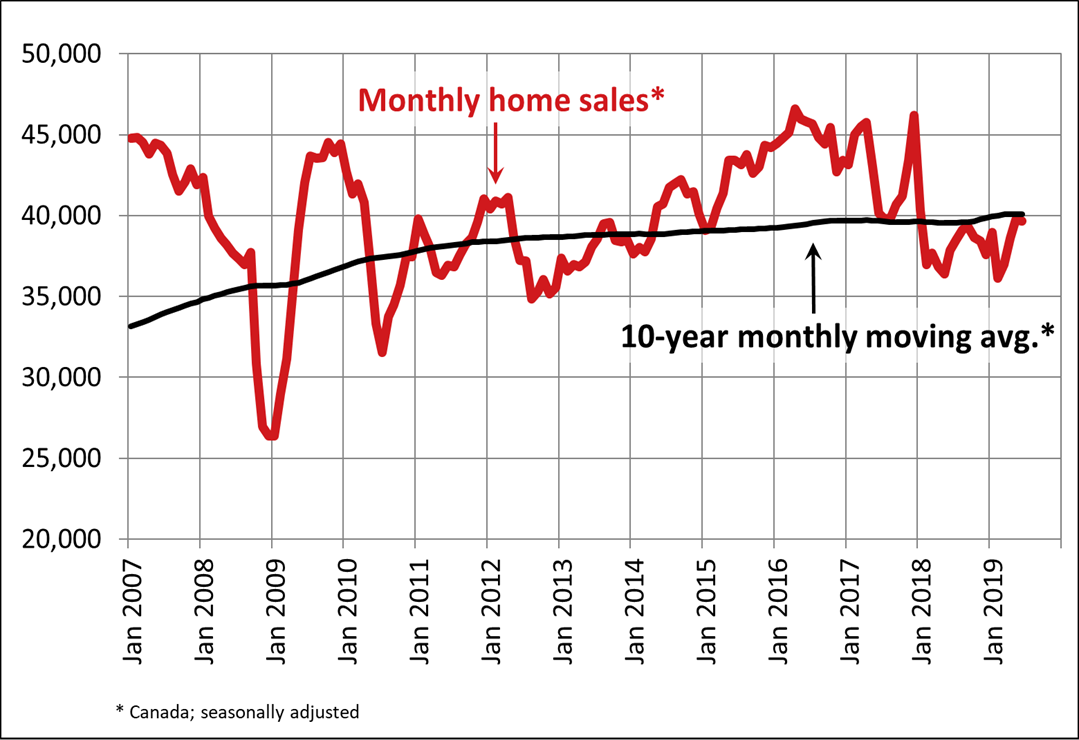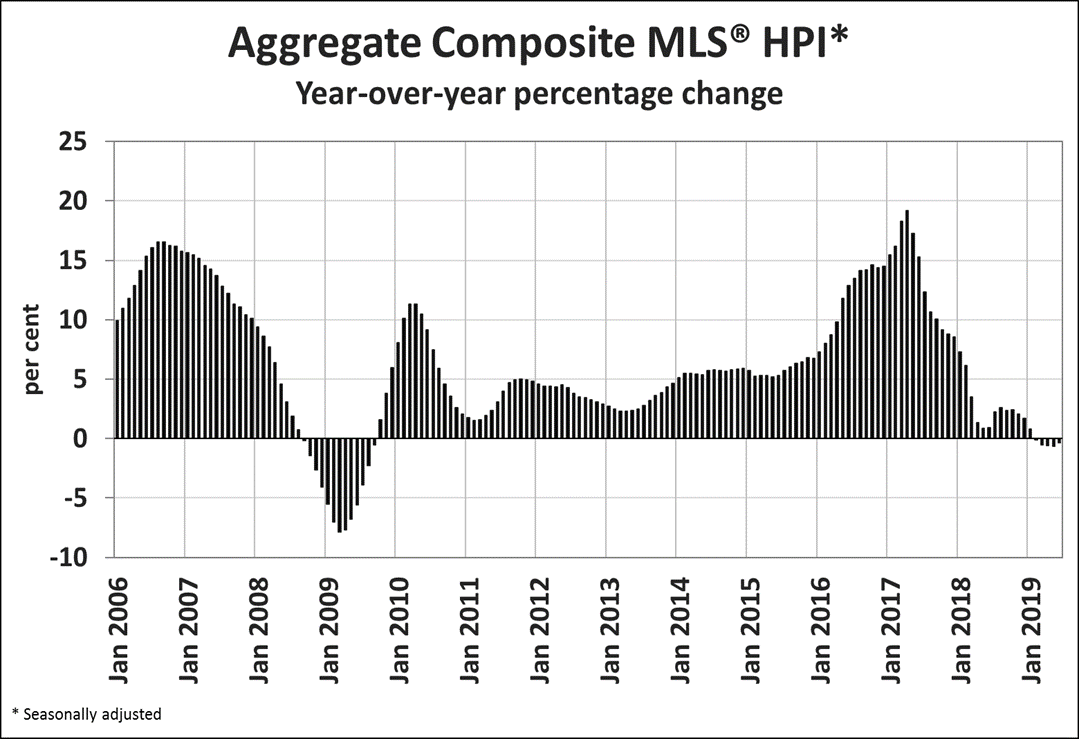
15 Jul Canadian home sales hold steady in June
Ottawa, ON, July 15, 2019 – Statistics released today by the Canadian Real Estate Association (CREA) show national home sales were little changed in June 2019 from the previous month.
Highlights:
- National home sales edged back 0.2% month-over-month (m-o-m) in June.
- Actual (not seasonally adjusted) activity ticked up 0.3% year-over-year (y-o-y).
- The number of newly listed homes rose 0.8% m-o-m.
- The MLS® Home Price Index (HPI) climbed 0.3% m-o-m in June but was down 0.3% y-o-y.
- The actual (not seasonally adjusted) national average sale price was up 1.7% y-o-y.
Home sales recorded via Canadian MLS® Systems were little changed in June 2019 following a string of monthly gains recorded in March, April and May. Although running close to its 10-year average and up nearly 10% from the six-year low reached in February 2019, activity remains well below levels recorded over much of 2015, 2016 and 2017. (Chart A)
The nearly unchanged national tally in June was the result of an even split between the number of local markets where sales were up and those where they were down. Larger monthly gains were generally focused in the province of Quebec and in Southern Ontario. Those gains were offset by declines in a diverse mix of markets across Canada, including Greater Vancouver (GVA), Calgary, Halifax-Dartmouth and the province of Newfoundland and Labrador.
Actual (not seasonally adjusted) sales activity edged up 0.3% compared to June 2018, with gains in Greater Toronto (GTA) and Montreal offsetting declines in B.C.
“Sales activity is strong in New Brunswick where I do business, but it’s a very different story in B.C., Alberta and Saskatchewan,” said Jason Stephen, CREA’s President. “All real estate is local. Nobody knows that better than a professional REALTOR®, who is your best source for information and guidance when negotiating the sale or purchase of a home,” said Stephen.
“There’s a growing divergence in Canadian housing market trends between eastern and western Canada,” said Gregory Klump, CREA’s Chief Economist. “While sales activity in Canada’s three westernmost provinces appears to have stopped deteriorating, it will be some time before supply and demand there becomes better balanced and the outlook for home prices improves.”
The number of newly listed homes edged up 0.8% in June. Stable sales and a slight increase in new listings caused the national sales-to-new listings ratio to ease marginally to 57.1% in June from 57.7% posted in May. This measure remains within close reach of its long-term average of 53.5%.
Considering the degree and duration to which market balance readings are above or below their long-term averages is the best way of gauging whether local housing market conditions favour buyers or sellers. Market balance measures that are within one standard deviation of their long-term average are generally consistent with balanced market conditions.
Based on a comparison of the sales-to-new listings ratio with the long-term average, over 80% of all local markets were in balanced market territory in June 2019, the largest share in over three years.
The number of months of inventory is another important measure of the balance between sales and the supply of listings. It represents how long it would take to liquidate current inventories at the current rate of sales activity.
There were 5 months of inventory on a national basis at the end of June 2019. While this is its lowest level since January 2018, this measure of market balance remains within close reach of its long-term average of 5.3 months.
While national measures of market balance are currently close to their long-term averages, which indicates a good balance between supply and demand, there are significant regional variations.
The number of months of inventory has swollen far beyond long-term averages in Prairie provinces and Newfoundland & Labrador, giving homebuyers ample choice in these regions. By contrast, the measure remains well below long-term averages in Ontario and the Maritime provinces, resulting in increased competition among buyers for listings and fertile ground for price gains.
Although the seasonally adjusted Aggregate Composite MLS® HPI rose 0.3% in June 2019 from the month before, it was still running 1.1% below the peak reached in December 2018. Looking past monthly variations, the overall trend has remained stable since March amid divergent regional trends. (Chart B)
Seasonally adjusted MLS® HPI readings in June were up from the previous month in 9 of the 18 markets tracked by the index, with virtually all of the gains recorded in housing markets east of the Prairie region.
Prices were flat on a m-o-m basis on Vancouver Island and in Calgary, Edmonton, Regina, Saskatoon and Moncton. Material declines were limited to the GVA (-1.3%), the Fraser Valley ( 0.8%) and the Okanagan Valley (-0.5%).
By contrast, monthly gains were posted in Barrie (+1.4%), Hamilton (+1.3%), Niagara (+1.2%), Guelph (+1.1%), Ottawa (+0.7%), Greater Montreal (+0.7%), the GTA (+0.6%) and Oakville (0.3%).
The actual (not seasonally adjusted) Aggregate Composite MLS® Home Price Index (MLS® HPI) edged down by -0.3% y-o-y in June 2019. For the second month in a row, all benchmark property categories tracked by the index posted y-o-y declines.
Two-storey single-family home prices were little changed from last June, edging back 0.1%. By comparison, one-storey single-family home prices posted the largest y-o-y decline (-0.8%) among benchmark property categories. Meanwhile, townhouse/row prices were down by 0.7% y-o-y and apartment unit prices edged back by 0.4%.
Y-o-y trends continue to vary widely across the country, with the main theme being a growing divergence in trends between eastern and western Canada.
Results remain mixed in British Columbia, with prices down on a y-o-y basis in Greater Vancouver (-9.6%), the Fraser Valley (-6.6%) and the Okanagan Valley (-0.8%). Meanwhile, prices edged up 0.5% in Victoria and climbed 4.2% elsewhere on Vancouver Island.
Among Greater Golden Horseshoe housing markets tracked by the index, MLS® HPI benchmark home prices were up from year-ago levels in Guelph (+6.8%), the Niagara Region (+6.7%), Hamilton-Burlington (+5.4%), the GTA (+3.6%) and Oakville-Milton (+3%). By contrast, home prices in Barrie held below year-ago levels (-2.4%).
Across the Prairies, supply remains historically elevated relative to sales and home prices remain below year-ago levels. Benchmark prices were down by 3.9% in Calgary, 3.2% in Edmonton, 4% in Regina and 1.1% in Saskatoon. The home pricing environment will likely remain weak in these cities until demand and supply return to better balance.
Home prices rose 8.3% y-o-y in Ottawa (led by a 13.2% increase in townhouse/row unit prices), 6.7% in Greater Montreal (led by an 8% increase in apartment unit prices), and 1.3% in Greater Moncton (led by an 18.4% increase in apartment unit prices). (Table 1)
The MLS® HPI provides the best way to gauge price trends, as averages are strongly distorted by changes in the mix of sales activity from one month to the next.
The actual (not seasonally adjusted) national average price for homes sold in June 2019 was just under $505,500, up 1.7% from the same month in 2018.
The national average price is heavily skewed by sales in the GVA and GTA, two of Canada’s most active and expensive housing markets. Excluding these two markets from calculations cuts almost $106,000 from the national average price, trimming it to less than $400,000.
– 30 –
PLEASE NOTE: The information contained in this news release combines both major market and national sales information from MLS® Systems from the previous month.
CREA cautions that average price information can be useful in establishing trends over time, but does not indicate actual prices in centres comprised of widely divergent neighbourhoods or account for price differential between geographic areas. Statistical information contained in this report includes all housing types.
MLS® Systems are co-operative marketing systems used only by Canada’s real estate Boards to ensure maximum exposure of properties listed for sale.
The Canadian Real Estate Association (CREA) is one of Canada’s largest single-industry trade associations, representing more than 130,000 REALTORS® working through some 90 real estate Boards and Associations.
Further information can be found at http://crea.ca/statistics.
For more information, please contact:
Pierre Leduc, Media Relations
The Canadian Real Estate Association
Tel.: 613-237-7111 or 613-884-1460
E-mail: pleduc@crea.ca



